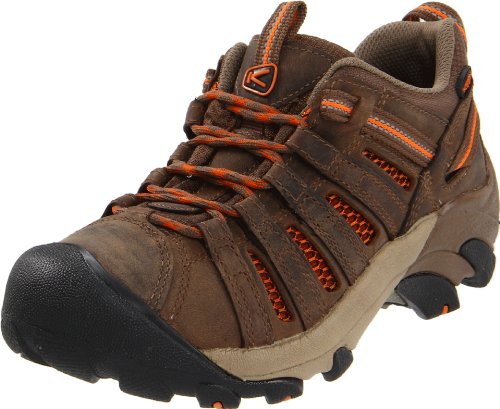Shoes See KEEN Women's Voyageur Hiking Shoe,Shitake/Burnt Orange,8.5 M US Details
Product Description
Like four-wheel drive for your feet, the Keen Women's Voyageur Hiking Shoes engage all gears when it comes to varied and rough terrain. Designed in a highly breathable mesh upper with leather and webbing support overlays, this trail shoes mesh ventilation windows backed with woven textile lining offer built-in climate control for cool circulation hot days while blocking out the rocks, sticks and dirt of the trail. Built with Keen's bomber patented toe protection, a torsion stability shank provides support and sharp object protection, as its S3 Heel Support Structure helps prevent your ankles from rolling over. A dual-density EVA midsole along with extra cushy padding at the gusseted tongue and ankle collar make for a plush ride. The Voyageur's secure-fit lacing system with leather eyelets and supportive heel wrap allows you to customize your level of support, while its non-marking carbon rubber outsole with4mm multi-directional lugs dig in for incredible traction over rock, sand, mud, and scree. With a bumper car-like toe protection, breathable and flexible drive-train, and performance lace and webbing steering, the Keen Women's Voyageur Hiking Shoes drive your peds where ever your legs choose to roam.
More About KEEN Women's Voyageur Hiking Shoe,Shitake/Burnt Orange,8.5 M US
The American USMC KA-BAR Fighting/Utility Knife became one of probably the most successful knives in use. Created by the Union Cutlery organization in 1941 this all-purpose survival tool was exclusively government order and designed to be effective as a defensive weapon, hammer, can opener, digging tool, and cutting tool.The origin of those initial prototype of those KA-BAR, the 1219C2, had its roots in World War I.
World War I
The stalemate entrenchment of World War I officially brought the fighting knife back to the battlefield. The trench systems in Belgium and France extended for hundreds of miles and close-quarter fighting between the Allied and German troops continued within the environment of the trench. Soldiers were required to cut-down their 19th century long-sword bayonets that most nations nonetheless issued. These cut-down weapons enabled close-quarter hand-to-hand combat.
It became apparent during the end of World War I that a brand name new knife design was needed to meet the demands of not merely close-quarter fighting but versatility of use. After detailed comparison of these trench weapons then in Make use of the United States and France started production of these Mark I Trench Knife, in 1918, through the last months of these war. Many of these weapons were never issued.
The Mark I was a cast-bronze knuckleduster. The pommel was secured to its cast-bronze hilt with a nut that had a significant point Which if employed with enough force can often fracture a mans skull. The weapon would be carried although crawling and kept securely in the hand. using a 7 double-edge blade, it was useful for thrusting and cutting. Yet, as a result of expense and soldier complaints of blade breakage, the Mark I had a short production life and just 120,000 were made.
With all the wars end in 1918 the evolution and development of those military fighting knife continued.
World War II
When the United States entered World War II in 1941 most Americans were armed Using the pre-World War II 16 M1905 Pattern Bayonet (later renamed M1942); and the U.S. Army had only one fighting knife the Mark I.
The Marine Corps issued the Marine Raider Stiletto to its elite forces but the stiletto was most helpful for silent killings Rather than general utility tasks. multiple Marines obtained their extremely own knives just before deploying. These were for probably the most part the hunting/utility knife L76 and L77 by Western States Cutlery.
The proposed reproduction of these Mark I was rejected as well as the U.S. Government requested military knife suppliers to develop specifications to get a modern fighting knife making use of the designs of the Mark I and the civilian hunting/utility knife patterns.
many changes to previous pattern designs resulted at the 1219C2 prototype. Made with thicker blade stock, extra fuller, straight cross-guard and peened pommel; it also had the now famous compressed leather washers at the handle. The 1219C2 was later coated with a non-reflective matte phosphate finish to reduce glare. (Marines to this day still add an added coat of black paint for glare reduction and corrosion resistance).
On November 23, 1942 the United States Marine Corps adopted the 1219C2 And also this it later re-designated the USMC Mark 2 Combat Knife. The United States Navy at the same time adopted the 1219C2 as the US Navy Utility Knife, Mark 2.
The Mark 2 became general issue in to the United States Marine Corps, and returning veterans were impressed by its combat effectiveness.
The Union Cutlery organization stamped their Mark 2 Combat/Fighting Utility knives Using the "KA-BAR" trademark, and as early as 1944 In any case of manufacturer all Mark 2s became known as the KA-BAR.
utilised in eight wars World War II, the Korean War, Vietnam, Grenada, Operation Just Cause, Gulf War, Afghanistan, and Iraq the KA-BAR has hit the mark as one of probably the most successful knives made.
Todays KA-BAR is made of 1095 Cro-Van Steel, flat ground, effortless to sharpen, and features a 20 degree edge angle and is effective as a combat knife and utility tool. using a hardness rating of 56-58 HRC, the moderate carbon and low chromium steel combination enables the blade to hold its edge very well.
and too the legend born during World War II continues, and over seventy years later the dual-purpose design is still doing its job.
KEEN Women's Voyageur Hiking Shoe,Shitake/Burnt Orange,8.5 M US Reviews
KEEN Women's Voyageur Hiking Shoe,Shitake/Burnt Orange,8.5 M US:Shoes



No comments:
Post a Comment